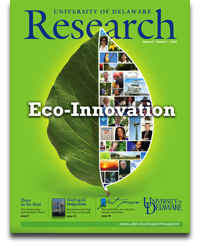In the field at
Toolik Field Station, Alaska
A tundra ecosystem and its effects on global warming
It takes hundreds of years for some environmental effects to become fully
realized. It’s a domino effect, meaning that what we do in this day and age will affect
generations hundreds of years from now.
Hence, what University of Delaware scientists are witnessing from their research
in the Alaskan tundra today near Toolik Field Station (TFS), about 150 miles
north of the Arctic Circle, is the result of a succession of environmental
changes that began taking place hundreds of years ago.
UD’s Tom Hanson, associate professor of marine biosciences and biological sciences, and Barbara Campbell, assistant professor
of marine biosciences, have been studying the effects of global warming on this
“arctic prairie.” The TFS, which is part of the U.S. Long-Term Ecological Research network, is
operated by the University of Alaska Fairbanks for scientists around the world.
Hanson and Campbell are working in collaboration with scientists Michelle Mack
and Ted Schuur at the University of Florida. Their project, funded by the
National Science Foundation, seeks to understand how changes in temperature and
nitrogen deposition in different soil layers of the tundra have affected this
fragile ecosystem.
In their study, nitrogen was added to plots on a yearly basis for 20 years,
mimicking what is happening naturally over a longer period. Their work will
enable them to determine if other tundra ecosystems will be similarly affected
by global warming.
“Understanding how changes in climate affect microbial populations will refine
predictions of how stored carbon will behave relative to existing trends in
global change,” says Campbell. “Changes found in this study may also reflect past climate change events, helping
scientists to understand the geological record.”
Changing microbial activity
Tundra soil, like that at TFS, is a large reserve of carbon derived from plants.
In fact, this soil is not granular, but rather an amalgamation of dead plant
leaves, Campbell says. Because it is so cold much of the year, these dead plant
leaves and detritus are not broken down, but instead accumulate.
However, climate change in the form of increased temperature or increased
nitrogen input to the soil appears to increase the breakdown of plant material
and the loss of soil carbon. This breakdown is carried out primarily by soil
microbes, leading to the release of carbon dioxide and methane that has been
observed in many tundra sites. Both are greenhouse gases.
“The soil freezes seasonally to become rock solid,” says Hanson. “It thaws in the late spring to early summer. But what’s relatively new is that increased nitrogen seems to be increasing microbial
activity and soil carbon loss. We are studying the DNA of the organisms
responsible for breaking down plant detritus and soil carbon to see if the same
microbes are just more active now, or if different types of microbes occur in
these more active soils.”
Hanson and Campbell have used a high-throughput sequencing technique called
pyrosequencing to analyze the DNA extracted from the soil samples.
“We used a novel method to identify between 5,000 to 10,000 microbes per sample
by sequencing a short fragment of DNA present in all organisms,” says Campbell. “This allowed us to get a snapshot of the microbial community in the soil
samples.”
These snapshots were compared between plots exposed to nitrogen and control
plots with no added nitrogen. Microbial community function — what types of carbon the microbes degraded — also was measured.
The results, published in the journal Environmental
Microbiology, indicate that
nitrogen additions changed both microbial community structure and function in
the soils exposed to nitrogen. This profiling of samples will allow scientists
to identify microbial DNA and functional markers that can then be identified in
other tundra microbial communities to signal that this same process — the loss of tundra soil carbon — may be occurring there as well.
“The goal of this research is to understand the role of microbes in this process,
so we can better document where and how fast carbon is being leaked from the
tundra,” says Hanson. “This will help us predict the future of other tundras around the world.”
Through their work, Hanson and Campbell have already seen indications that
change has occurred in the soil samples from Alaska. The next step is to study
the mechanism of the microbes and how it contributes to the soil carbon loss — and to recognize what functions are being lost as well. Hanson will be working
on this during a visit to the DSMZ, the German Collection of Microorganisms and
Cell Cultures, in Braunschweig, Germany, where he will be trying
to culture relevant microbes from the Toolik tundra.
“We have seen major changes in how the microbes are behaving,” he says. “The functions seem to be different as well, leading us to believe there is a
correlation between the change in the microbial community’s structure and the change in function.”
It’s clear from this research, as well as other reports, Hanson says, that nature’s carbon footprint has increased because the human carbon footprint has
increased. The world is changing, as some of our most beautiful natural
phenomena degenerate — and this is one more great reason we should continue down the path of becoming
more Earth friendly.
“A lot of studies indicate that if we made some changes today, and reduced our
carbon footprint by 50 percent, we might see some significant, positive,
changes in the environment in 50 to 100 years at the earliest. It’s going to take that long,” says Hanson.
It’s a domino effect.
 Toolik Field Station encompasses 87,000 acres in the northern foothills of Alaska's Brooks Mountain Range. It has been a major location for scientific research in the Arctic since 1945.
Toolik Field Station encompasses 87,000 acres in the northern foothills of Alaska's Brooks Mountain Range. It has been a major location for scientific research in the Arctic since 1945.
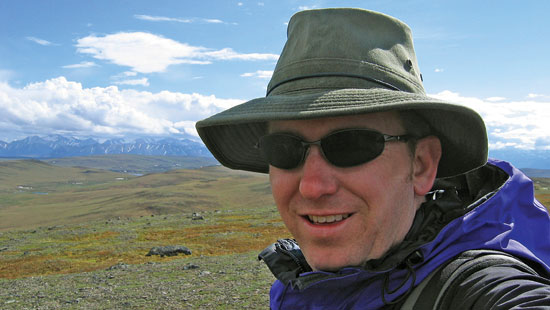 As a result of global warming, UD's Tom Hanson, associate professor of marine biosciences and biological sciences, says "[w]e have seen major changes in how the microbes are behaving."
As a result of global warming, UD's Tom Hanson, associate professor of marine biosciences and biological sciences, says "[w]e have seen major changes in how the microbes are behaving."
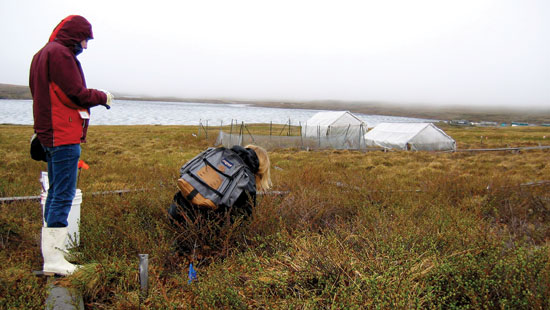 About a hundred researchers each summer pursue projects in the tundra ecosystem at Toolik Field Station in the Alaskan arctic. Here, the UD team is shown collecting soil samples for microbial analysis.
About a hundred researchers each summer pursue projects in the tundra ecosystem at Toolik Field Station in the Alaskan arctic. Here, the UD team is shown collecting soil samples for microbial analysis.
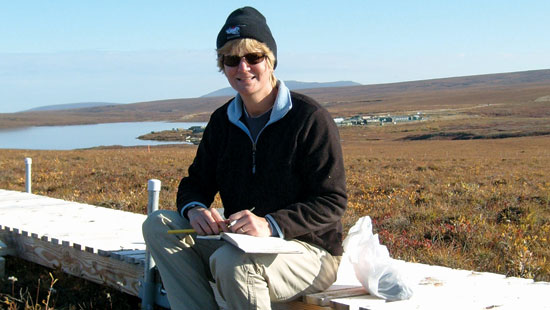 Barbara Campbell, assistant professor of marine biosciences, records soil data during summer field work in the Alaskan tundra about 150 miles north of the Arctic Circle.
Barbara Campbell, assistant professor of marine biosciences, records soil data during summer field work in the Alaskan tundra about 150 miles north of the Arctic Circle.
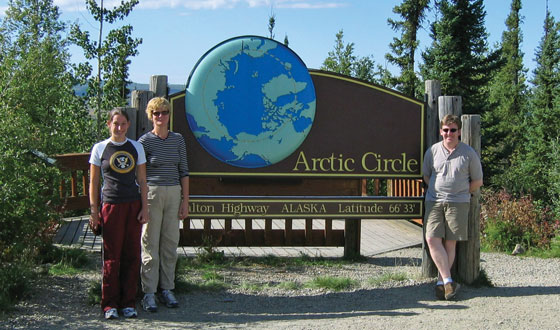 The University of Delaware team at the Arctic Circle in the summer of 2009.
The University of Delaware team at the Arctic Circle in the summer of 2009.





